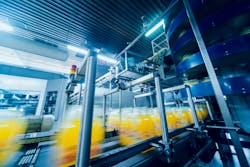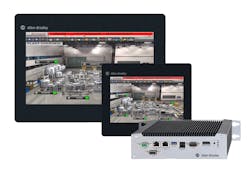Are You and Your Machines Ready for Centralized Computing?
Industrial PCs have been a fixture on the plant floor for decades. But the need to configure, maintain, and secure distributed computing assets can be a hassle. That’s why more and more industrial end users are transitioning to centralized computing.
In the simplest terms, centralized computing involves running applications and processing data from a central server location instead of from distributed industrial PCs. The servers use software to deliver content to plant workers on what are known as thin clients. These are lightweight computers with minimal processing and memory requirements.
Centralized computing is becoming popular with end users for good reasons: It can help lower IT costs, reduce downtime risks, and enhance security. And the impacts on operations are almost zero. Plant workers can still access the information that they need, when they need it, to run production and service machines.
As more companies look to adopt centralized computing, they expect their OEM partners to help them. That’s why it’s important that you understand the technology involved and how to deploy it.
Thin Clients: A Better Alternative to PCs
Thin-client devices and software aren’t just enabling technologies for centralized computing—they also offer many benefits over industrial PCs.
For example, thin clients can provide a lower total cost of ownership. They don’t have hard drives or fans, making them less likely to fail and cause downtime than industrial PCs. And because thin clients can be managed from a thin-client software, they can be more easily updated and replaced than PCs.
Thin clients are also smaller and need less power for operation and cooling. And they have fewer operating systems that end users need to be familiar with and be able to maintain.
Thin clients can also be more secure than industrial PCs. They have no local storage, so end users don’t need to worry about losing data if they go missing. And their USB ports are blocked by default, which means attacks can’t be easily introduced onto an industrial network.
Food Producer Goes Thin
One leading food producer was struggling with legacy computer HMIs in one of its plants. The computers weren’t built for harsh manufacturing environments and were failing at an almost weekly rate. Many of them were also running an obsolete operating system.
The company replaced the desktops with thin-client HMIs, then used thin-client software to centralize management and delivery of the HMI software from the servers to the thin clients.
Even with only one-third of the computers replaced, the plant has started seeing benefits. The thin clients are designed for harsh environments, giving them a vastly improved life expectancy. The thin clients can also be more easily replaced.
“Instead of rebuilding the HMI from scratch, all we need to do is replace the thin client,” the site’s electrical engineering lead said. “That drastically improves replacement time from about six hours to a matter of minutes.”
VersaView 5200 Thin Clients exclusively integrate with ThinManager software. The thin clients are used to display content delivered from a remote ThinManager server. You can have multiple thin clients set up across your plant or facility with various roles with the convenience of having them all maintained by the ThinManager server.
Four Deployment Use Cases
So how can you deploy centralized computing in your machines or equipment to help end users? Consider four potential use cases:
1. Mirrored views. Long machines or production lines can’t always be managed from a single workstation. Rather than adding more industrial PCs along the machine or line, you can add thin clients. This can save you the cost of building more workstations. And because the thin clients simply mirror the view of the main workstation, you don’t need to pay for more licenses.
2. Location-based content. Some machines or lines with multiple sections don’t need additional terminals for day-to-day operations. But you may want to give workers occasional access to information at different points, such as for maintenance purposes. Thin-client software with location-based content delivery allows you to do this. You simply place QR codes where workers will access machine or line information. Workers can then scan the codes with a mobile device and access content right there, with the mobile device acting as the thin client.
3. Multi-content HMI. Complex machines often deliver content to operators from multiple sources, like controllers, on-machine cameras, and the web. In these instances, a thin-client software with multi-session and virtual-screen technology can deliver all that content to a single terminal. The resulting display is almost like a mini-control room: one place for a worker to get all the information they need. The content can also be customized to different users, like machine operators, maintenance technicians, and quality managers.
4. Line integration. Thin-client technology can create a single control-room view of multiple machines spread across a plant. In these situations, multi-session and virtual-screen technology can monitor different machines and bring them together into one centralized view. And it can achieve this integration even if the machines are from different vendors and don’t integrate well.
Impacts on Machine Design
Machines have traditionally been self-contained, meaning you can set up, configure, and test each of them as they’re built. But you can’t do this with machines built for a centralized computing environment. A central server is needed to run all of a plant’s machines together—and machines rarely all arrive in a plant at the same time.
Thin-client software can provide an easy and straightforward workaround for this challenge. You simply configure all the machines that you’re going to deliver on a laptop, which acts as a temporary server. And that configuration will match the server configuration in your customer’s live environment.
As machines are built, you can activate the parts of the thin client that will be needed for that specific machine. And as the machines arrive at customer locations, customers can test them based on the provided configuration. It’s just a matter of switching the machine’s configuration from the laptop to the permanent server.
Selecting the right thin-client technology is also crucial. You should be using hardware and software that is specifically designed for the industrial space. For example, changing a thin-client’s display or redistributing content across multiple views should only take a few clicks. Thin clients should also have flexible mounting options and be designed for harsh industrial environments.
A New Role in a Changing Landscape
As industrial companies connect their operations and make information seamlessly shareable, they don’t want machines with pockets of computing. Instead, they want to be able to run applications from a centralized location. And they want information gathered and presented in a cohesive manner.
By transitioning your machines to a centralized computing approach, you can help customers make this happen. And you can set yourself apart from your competitors by becoming a trusted partner for centralized computing.
Tom Jordan is the ThinManager marketing lead for Rockwell Automation.


